|
|
Some articles have not been moved to our new site yet.
As a result you have been redirected to our old site.
If you wish to return to our new site - click here.
THE GOVERNMENT"S DRUGS POLICY: IS
IT WORKING?
Submission of Independent Drug Monitoring
Unit
Matthew J. Atha BSc MSc LL.B & Simon
Davis DipHE (SocSci)
to
House of Commons Home Affairs Select Committee
Enquiry
Foreword
F1 The
issues raised by the committee are complex, and cannot
adequately be addressed within a limit of 1000 words.
We have however endeavoured to keep the length of
this document to a minimum, whilst addressing all
the major issues raised by the committee, and question
arising therefrom.
F2 IDMU
is a small independent research consultancy specialising
in the study of illegal drug consumption patterns,
prices and effects. We are funded wholly via professional
fees earned in providing expert evidence for the criminal
and civil courts, with experience of over 900 criminal
cases since 1991. The evidence mainly covers personal
consumption and drug valuations, but includes yields
of cannabis cultivation systems, effects of drugs
(re criminal intent, driving impairment etc.), and
a range of other aspects, most notably therapeutic
uses of cannabis. Our mission is to provide accurate,
up to date and impartial information on drugs to all
parties to the debate over drugs policy. Other than
legal casework, we have provided consultancy for GW
Pharmaceuticals, the House of Lords enquiry, the Home
Office, Transport Research Laboratory, and Northamptonshire
Police.
Executive
Summary
S1 Existing
drug policy is clearly not working, for reasons outlined
herein.
S2 Decriminalisation
is a vague term which requires clarification
S3 The
effect of law reform on availability of and demand
for drugs would depend upon the policies adopted.
Alternative methods of control could reduce the availability
of drugs, particularly to young people, who view legislation
as a challenge rather than a deterrent.
S4 The
effect of law reform on drug-related deaths would
depend on the drug and upon the policies adopted.
Pragmatic reforms could cut the number of drug-related
deaths significantly.
S5 The
effect on crime would depend upon the policies adopted.
Options are outlined which could lead to a substantial
fall in acquisitive crime.
S6 Decriminalisation
(permitting possession but not supply) could have
advantages and disadvantages. The main disadvantage
would be to leave the supply of drugs in criminal
hands.
S6 There
are a number of practical alternatives outlined. A
system of regulated and licensed supply could avoid
many problems currently experienced, and raise substantial
revenues (£1 to £5 Billion per year) for the exchequer
from a combination of excise duties, greater productivity,
and reduced law enforcement costs.
S7 The following
appendices are provided with the report
A Medicinal
Use of Cannabis
B Drug
Driving
C Drug
Trends (IDMU survey research data 1984-2000)
D How
IDMU can contribute to policy development
1 Does
existing drugs policy work?
1.1 The
question raises several issues:
(a) What
are the goals of current drugs policy
(b) By
what criteria can existing policy be judged
(c) How
is current policy performing against such criteria,
what are the successes and failures
(d) To
what extent are current successes adequate, and
failures acceptable
1.2 The
goals of drugs policy can range from the absolutist
achievement of a "drug free society", to
the pragmatic "harm minimisation" approach.
For the absolutists, being seen to "fight the
fight" at all costs, is more important than achieving
practical results. Those favouring the pragmatic approach
would seek to minimise the harm caused by drugs, both
to the individual and to society.
1.3 A
range of criteria can be used to evaluate the effectiveness
of drug policy - these can include:
(a) Prevalence
- all drugs and/or more dangerous/addictive drugs
(i)
Lifetime drug use
(ii)
Current/recent drug use
(iii)
Problem drug use (treatment episodes)
(iv)
Drug arrests
(v) Teen
drug use (age of first use)
(b) Drug
related deaths
(i) Poisonings/overdoses
(ii) Accidental
deaths
(iii) Suicides
(iv) Deaths
from health problems caused by chronic drug
use
(c) Crime
(i) Drug-trafficking
(ii) Acquisitive
Crime
(iii) Drug-related
violence
(iv) Prostitution
(d) Market
trends - all drugs and/or more dangerous/addictive
drugs
(i)
Drug availability
(ii) Drug
Prices
(iii) Drug
Purities
(iv) Attitudes
to drugs
1.4 Taking
a global view, there is overwhelming evidence that
current drug policies do not work.
(a) Prevalence,
particularly of Class A drugs is increasing.
(b) Lifetime
prevalence will continue to increase for the next
couple of decades irrespective of drug policies,
until more users/ex-users start to die out through
old age or ill health than new teenagers initiate
drug use - evening out the demographic bulge.
(c) The
key policy objective should be to minimise the
number of people initiating or continuing to use
Class A drugs.
(d) Our
surveys suggest that the effect of an arrest on
drugs charges is to increase the probability of
that person progressing to use of class A drugs.
(e) Drug-related
death rates in the UK are much higher than many
other countries, most notably the Netherlands
and others with more liberal regimes.
(f) Current
policies also fuel crime via maintaining the cost
of addiction at high levels, and providing high
profit margins for drug traffickers.
(g) Availability
of drugs is increasing, drug prices are falling,
in some cases dramatically, and purities are increasing.
(h) The
public at large is growing increasingly tolerant
of drug use, notably cannabis, although attitudes
among drug users to different drugs appear relatively
stable.
2. What
would be the effect of decriminalisation on
(a)
the availability of and demand for drugs
(b)
drug-related deaths and
(c)
crime?
2.1 The
term "decriminalisation" causes much confusion.
It may be used broadly to reflect a general move towards
relaxing the current regime, or narrowly to mean permitting
personal possession (e.g. below a certain limit) but
maintaining criminal controls on drugs supply. By
contrast the term Legalisation would normally be taken
to mean abolishing legal controls and permitting a
free market in supply of drugs. Regulation or licensing
would introduce a degree of control whilst permitting
a legal supply of drugs - the degree of control could
vary from the off-licence/tobacconist model for the
less dangerous drugs, and/or on-licence such as cannabis
pubs or cafes, to prescription only for the drugs
of addiction.
2.2 The
key to reducing demand for drugs is to make drug use
"boring" or "uncool", and reduce
the excitement and glamour associated with the drugs
scene. Availability, particularly to minors, could
be reduced if age-limited legal sources were available,
reducing the profits from selling drugs, and if addicts
did not need to sell class A drugs to support their
own habits.
2.3 Most
drug-related deaths are caused by drugs of unknown
purity, contaminants within illicit preparations,
and unsafe practices associated with drug use.
(a) Heroin/Opiates
(i) Illicit
heroin powders can range in purity from under
10% to over 70% - injecting drug users are
therefore at risk if they take a "normal"
dose of high purity powder.
(ii) Heroin
addicts who are abstinent (e.g. through rehab
or prison) lose tolerance to the drug, and
are at risk of overdose if they relapse and
inject a "normal" dose.
(iii) Recent
outbreaks of heroin deaths have been caused
by microbial or viral infections, serious
health complications (abscesses, amputations
etc.) arise from other contaminants when injected
(iv) Allowing
GPs to prescribe heroin, in injectable form
where appropriate, of pharmaceutical purity
and of known dosages, could dramatically cut
the death rate from overdoses and impurities
- the experience in Switzerland and Australia.
(b) Stimulants
(Cocaine, Amphetamine)
(i) Deaths
attributed to cocaine and amphetamine generally
involve cardiovascular effects (strokes, heart
attacks) caused by the drug itself.
(ii) Relaxation
of the law is unlikely to have a significant impact
on stimulant-related deaths, unless this were
to result in an increase in stimulant use, and
of excessive binge use in particular.
(iii) Permitting
low-dosage or natural preparations (e.g. coca
tea) may be one way to provide a legal supply
of stimulants. Caffeine use also carries risks.
(c) Ecstasy
- Deaths attributed to ecstasy fall into the following
categories
(i) Dehydration/heat-stroke
arising from the circumstances in which the drug
is taken (hot, sweaty atmosphere, intense and
prolonged physical activity)
(ii) Adverse
reactions - toxic effects of the drug often involving
liver failure
(iii) Deaths
attributable to impurities (e.g. ketamine/ephedrine/procaine
combinations)
(iv) Evidence
as to the neurotoxic effects of MDMA is compelling
- Long-term use of the drug is likely to result
in chronic mental health effects.
(v) If
"decriminalisation" were to result in
increased use, deaths could increase. Steps should
therefore be taken to screen all phenethylamine
analogues identified by Shulgin with a view to
licensing alternative drugs which carry more acceptable
health risks whilst retaining acceptability to
the users.
(d) Cannabis/Hallucinogens
- few, if any, deaths are attributed to cannabis
or the tryptamine hallucinogens (LSD, DMT, Magic
Mushrooms) although the latter can cause long-term
mental effects in susceptible individuals.
(e) Long-term
health risks
(i) Health
risks associated with clean opiates are relatively
low, the major cause of ill health is unsafe practices
associated with use (smoking heroin, unsterile
injection) or impurities or adulterants present
in illicit preparations.
(ii) Use
of stimulants (amphetamines, cocaine, ecstasy)
increases long-term risks, notably of cardiovascular
problems (cocaine/amphet) and serotonin depletion
(ecstasy). Increased use would be expected to
increase associated death rates.
(iii) Cannabis
- Unlike in the USA, where herbal cannabis is
smoked "neat", in the UK most cannabis
or cannabis resin is smoked mixed with tobacco,
which carries its own risks. Increases in smoking
any substance are likely to increase long term
risks from cancer, pulmonary or cardiovascular
disease. Increased use of alternative forms of
administration (food or drink products, inhalers/sprays
etc.) in a legal market could reduce the risks
from smoking. The health risks associated with
the use of cannabis have been thoroughly investigated
over the past century, and there is no evidence
that increased use of cannabis would have a significant
adverse impact on public health.
2.4 The
effect on crime would depend on the nature of
the policy, and the type of crime involved:
(a) Acquisitive
crime - This would include theft (burglary,
robbery, shoplifting), fraud (petty credit-card
fraud, benefits fraud, and larger-scale financial
embezzlement).
(i) A
substantial proportion of acquisitive crime is
driven by the need to find money to buy the addictive
drugs - heroin and, to a lesser extent, cocaine.
(ii) Any
policy which permitted possession of heroin but
did not permit a legitimate supply would be unlikely
to cause a significant reduction in acquisitive
crime.
(iii) Prescription
of diamorphine preparations, at nominal cost,
or even at cost price where there is the ability
to pay, should result in a dramatic reduction
in acquisitive crime.
(iv) Were
acquisitive crime to fall dramatically, and stolen
goods no longer need to be replaced by victims
(on insurance or otherwise), there could be an
adverse impact on manufacturing industry from
such a reduction in consumer demand.
(b) Trafficking-related
violence (turf wars etc.) - the death rates
would be broadly linked to the profit margins
available, and risks involved, within the illicit
trade.
(i) A
policy which permitted personal possession but
left supply of drugs in criminal hands could result
in an increase in violent deaths (assassinations/murders)
within the drugs trade, if such a policy were
to increase demand
(ii) A
policy of licensed distribution of cannabis would
only remove the profit incentive if levels of
excise duty were not excessive. Any duty levied
in excess of £1.50 per gram would encourage "bootlegging"
on a similar scale to that currently seen with
alcohol and tobacco.
(iii) Prescription
of heroin would remove the profit incentive in
the drugs trade, rendering it uneconomic, abolishing
turf wars for drug supply
(iv) If
the consequences of arrest on trafficking charges
were to be less severe, there may be reduced motive
to assassinate suspected informers within trafficking
organisations.
(c) Drug-Induced
Violence
(i) Stimulants
- amphetamine and cocaine are associated with increased
aggression and psychotic behaviour, particularly when
used to excess. The incidence of such behaviour, and
violent deaths arising from stimulant use, would be
expected to increase with a wider increase in use.
(ii) Alcohol
- Alcohol is a causal factor in the majority of violent
incidents in society. If policies were to reduce alcohol
consumption, fewer violent deaths might result.
3. Decriminalisation
and alternatives
3.1 Is
decriminalisation desirable?
3.1.1 If
decriminalisation involves removing criminal penalties
for possession (e.g. of less than a designated
amount), but leaving supply of drugs in the hands
of criminals, there would be some benefits, but
many problems would remain.
(a) Benefits
(i) The
move would be popular among users of drugs,
reducing the levels of conflict between
young people, police and society
(ii) Removing
the threat of a criminal record (and/or
expunging existing criminal records for
simple possession) would reduce the financial
impact of an arrest on the individual
and society.
(iii) The
credibility of government messages among
wide sections of society may increase.
Our recent survey showed that the least
trusted sources of drugs information were
Government Ministers, the Drugs Czar,
and the Police.
(iv) Society
as a whole could benefit from a more tolerant
climate of individual rights and responsibilities,
with a less authoritarian relationship
between the government and its citizens.
(b) Problems
(i) Leaving
civil penalties in place for possession
would not remove the "naughty"
or "forbidden fruit" image of
drugs, and would decrease the attractions
of usage.
(ii) Civil
fines would be paid by a small minority
of users (those who are caught), and would
therefore represent a very inefficient
form of taxation.
(iii) If
demand increases, the untaxed profits
of drug traffickers would increase, and
with this the levels of corruption and
violence associated with any illegal trade.
(iv) Decriminalisation
would mean users still having to get their
supply from a source. If the "legal"
source of drug (GP, licensing) is inferior
in quality to the "illegal"
sources, then the criminal control of
the drug trade would not be halted. To
be effective the criminal element that
controls the supply of drugs must be put
out of business. This can be achieved
by ensuring the supply of drugs is at
least of a standard users are already
accustomed to. In the case of cannabis
the easiest solution would be to allow
anyone to grow their own supply for own
personal use only. This would enable relatively
law abiding citizens who only smoke cannabis
to avoid visiting criminal suppliers.
(v) The
government would not benefit from Excise
Duty revenues payable on (particularly)
cannabis. Our surveys have indicated that
such duties, along with reduced enforcement
costs, could generate between £2 Billion
and £5 Billion per year for the exchequer.
3.2 If
not, what are the practical alternatives?
3.2.1 Status
Quo - No change in legislation. Public opinion
is steadily moving towards support of drug law
reform and some form of liberalisation. Opportunities
have been missed in the past (e.g. following Wooton
Report and 1979 ACMD report) to reduce the criminal
status of cannabis, and those failures are at
least in part responsible for the levels of drug
problems we face today (ten times as many drug
users/arrests today as when the Misuse of Drugs
Act was introduced)
3.2.2 Reduce
penalties (reschedule cannabis to class C,
Ecstasy/LSD etc. to class B) - These proposals
from the Police Foundation in essence echo those
of the ACMD in 1979. This would represent tinkering
with the system, as the damaging effects of a
criminal record for drugs on the individual and
society would remain.
3.2.3 Regulation/Licensing:
In the long term, some form of regulated supply
of cannabis must be considered. The extent to
which licensing could cover existing illicit preparations
would depend on international agreements (i.e.
for cannabis resin or herbal imported from countries
where production remains illegal), although domestic
production could supply the bulk of the UK cannabis
market. The objective of such models would be
to satisfy existing demand without creating additional
demand. Different models may be appropriate for
different drugs:
(a) Prescription
and dispensation from Pharmacy - this
could be appropriate for opiates, but would
impact on NHS resources (GPs" time).
Individual use could be regulated.
(b) Individual
licenses to possess/purchase - Users could
apply for a licence (smartcard?) which would
enable them to buy (e.g. opiates) in appropriate
amounts at or near cost price.
(c) Licenses
to produce - cannabis growers could be
allowed a "duty free" surface area
or lighting wattage, but could apply for licenses
to produce larger amounts. Duty could be levied
at quarterly intervals based on the available
surface area, subject to regular inspection.
(d) Licensed
supply
(i) Outlets
such as "coffee shops" could
be licensed to supply cannabis, with appropriate
restrictions on advertising, age restrictions
(as with alcohol or tobacco), and location
(e.g. not within 1/4 mile of a school).
(ii) Alternatives
would include a "club" model
whereby licensed clubs could supply cannabis
to their members, who would have to produce
a membership card. Reciprocal agreements
could allow cards to be valid in all clubs
within an association.
3.2.4 Free
Market (Legalisation) - This would involve
drugs being sold in normal retail outlets (e.g.
supermarkets/tobacconists) without significant
controls. Excise duties could be levied on producers
and/or wholesalers as with tobacco or alcohol.
This policy would probably lead to increased usage
(particularly among middle-aged or elderly citizens),
although this would also generate the highest
duty revenues for government.
Appendix
A - Medicinal Use of Cannabis
A1 I
have appeared in court as an expert witness in numerous
cases where defendants have claimed to be using cannabis
for therapeutic purposes, either in mitigation or
claiming necessity. Most Crown Court trials, where
defendants have invoked the defence of "duress
of circumstances", have resulted in jury acquittals
on all charges.
A2 Irrespective
of policies on other aspects of drug legislation,
this issue should be addressed as a matter of urgency.
The Attorney General should draw up guidelines for
prosecuting authorities as many prosecutions clearly
fail to take account of either the reasonable prospects
of a conviction, or whether such a prosecution would
be in the public interest.
A3 At
present, prosecutions would fail to reach the 51%
threshold in all cases involving simple possession
or personal cultivation (production) for relevant
medical conditions (including chronic pain, Multiple
sclerosis and other movement disorders, cancer chemotherapy
or AIDS, epilepsy or glaucoma. Perhaps a designated
list should be maintained of conditions for which
prosecutions should not proceed where a medical diagnosis
is provided. In cases of supply to a medicinal user,
prosecutions are again unlikely to succeed, nor would
"possession with intent" charges on relatively
large amounts claimed to be for personal use, unless
there is other (paraphernalia) evidence of dealing.
In cases of other medical conditions, the CPS should
seek expert advice before contemplating prosecution.
A4 Such
a policy should not fetter the hands of the CPS where
medicinal use is incidental to commercial supply of
drugs, or other criminal offences.
Appendix
B - Drug Driving
B1 The
law currently prohibits driving "whilst unfit
through drink or drugs". The current law does
not require major modifications to be effective. However,
there may be a case for secondary legislation to be
amended to provide more effective enforcement.
B2 To
secure a conviction, the police/Crown must prove that
(a) The
driver was under the influence of drugs
(b) His
ability to drive properly was for the time being
impaired
(c) That
the impairment was due to drugs rather than other
factors (e.g. disability, illness, fatigue etc.)
B3 IDMU
has been consulted by the Transport Research Laboratory
and Northamptonshire Police in developing more effective
methods of enforcement for the existing laws.
B4 The
"field impairment testing" (FIT) currently
being adopted by many police forces, represents an
improvement on previous enforcement techniques, but
fails to address abilities which are directly related
to the ability to drive, in particular reaction time
and tracking ability. These could be addressed via
development of an in-car simulator to allow suspects
to be tested at the time, with objective pass/fail
standards. We have also recommended that all FIT tests
are recorded on videotape where such facilities exist
within a police vehicle, as too much of the present
test is subjective on the part of the police officer
involved.
B5 The
taking of samples of blood for drugs provides a snapshot
at the time the sample is taken, which may represent
a baseline level or the residue of a higher dose influencing
the driver at the time (particularly for cases involving
cannabis). We recommend that legislation be amended
to require the taking of at least two samples a fixed
time (e.g. 15 minutes) apart to determine whether
a drug level is stable or declining, and to enable
back-calculation to the time of the incident in question.
B6 Despite
much public alarm, the effect of most controlled drugs
on driving provides less of a risk of accidents than
alcohol or prescribed benzodiazepine drugs:
(a) Cannabis
- Increased risk for new users or new drivers,
for established users/drivers appears to reduce
accident risk by improving driver behaviour (slower
speeds, larger gap, fewer risky manoeuvres) compensating
for any performance impairment (tracking ability
may be affected, no effect on reaction time)
(b) Stimulants
- Low doses of amphetamine or cocaine may improve
performance (alertness, quicker reaction times),
although high doses impair judgement (overconfidence,
aggressiveness)
(c) Opiates
- Impair našve users, addicts probably drive better
with drug in system than when withdrawing
(d) Ecstasy
- Our surveys suggest significantly increased
risk of accidents, but may be confounded by social
factors (e.g. fatigue due to driving in the small
hours of the morning when returning from clubs/raves)
(e) Hallucinogens
- severe impairment of perception and judgement
- few users would contemplate driving under the
influence.
Appendix
C - Drug Trends
C1 The
following pages represent data from IDMU surveys conducted
between 1984 and 2000. Surveys were all conducted
using anonymous questionnaires distributed at pop
festivals and other outdoor events. A number of "core"
questions appear each year, allowing year on year
comparisons to be made. The number of respondents
in each year were as follows
1984
- 607, 1994 - 1333, 1995 - 191,
1997 - 1136, 1998 - 1153, 1999
- 2173, 2000 - 2352
C2 Drug
Prevalence
C2.1 The
lifetime prevalence of using most drugs has remained
relatively stable among the user population as
a whole, however amphetamine and LSD appears to
be declining steadily, whereas cocaine and ecstasy
appear to be increasing slightly. Prevalence of
magic mushroom use (not shown) is similar to that
of LSD. Crack and Ecstasy were not listed options
in 1984, although 1% mentioned MDA as a write-in
option. Users of crack in 1984 (then known as
freebase) did not report it directly, but some
of the cocaine would have been used in that form
Fig
1 - Lifetime prevalence of use of different drugs among
users of any drug by year

C3 Frequency
of use
C3.1 Users
of each drug were asked to state how often they used
the drug. Other than cannabis and legal drugs (caffeine,
tobacco, alcohol), there were few daily users, with
experimental or occasional use the norm.
Fig
2.1 Frequency of Cannabis use by year
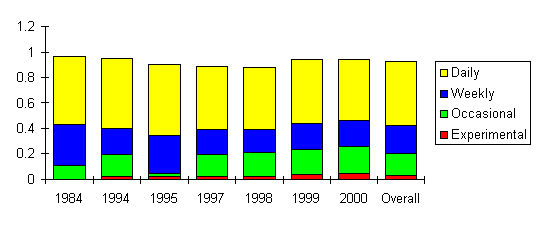
Fig
2.2 Frequency of Amphetamine use by year
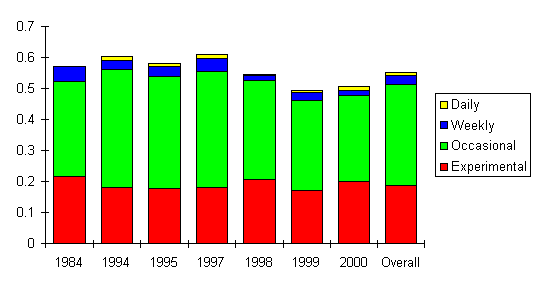
Fig
2.3 Frequency of LSD use by year
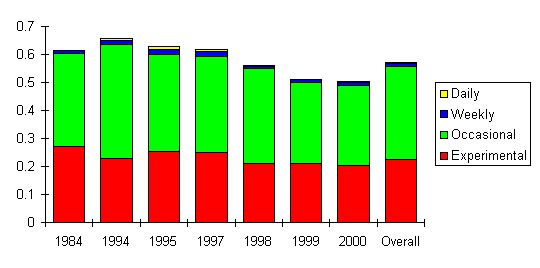
Fig
2.4 Frequency of Ecstasy use by year

Fig
2.5 Frequency of Cocaine use by year
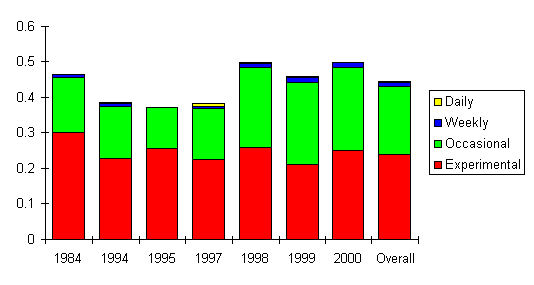
Fig
2.6 Frequency of Crack Cocaine use by year
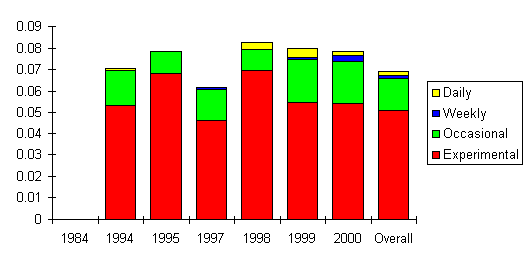
Fig
2.7 Frequency of Heroin use by year

C4 Retail
Prices
C4.1 Prices
of cannabis resin have been falling steadily since
1994, actually having peaked in the late 1980s, with
the most substantial falls seen since 1998. Data for
a range of cannabis resin and herbal varieties are
available, only the most common Moroccan/Soap Bar
resin is shown. Prices for imported herbal cannabis
are also in decline, as is the market share, which
has been overtaken by domestically produced cannabis
(skunk). Skunk prices have remained relatively stable,
with roughly a 50% price premium as compared to resin.
Fig
3.1 - Cannabis Resin Price Trends
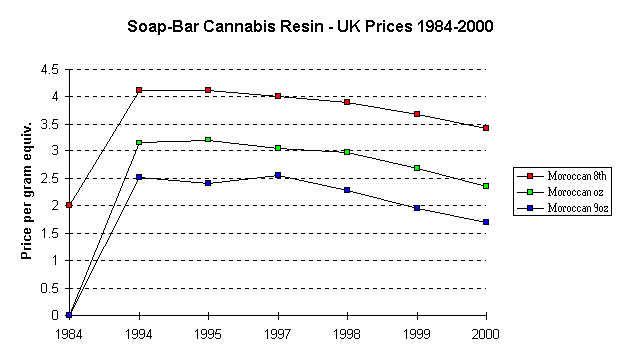
C4.2 Prices
of amphetamine have again remained relatively stable,
although the average purity has increased substantially.
LSD prices are becoming less commonly reported, and
remain stable. Ecstasy prices have fallen by nearly
50% since 1995, and the fall appears to be continuing.
Fig
3.2 - Retail price trends for amphetamine, ecstasy and
LSD
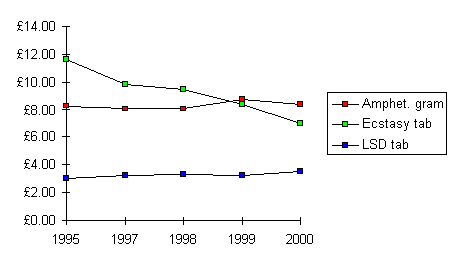
C4.3 Prices
of cocaine and crack have remained stable, although
the purity of cocaine is increasing at street level.
Heroin prices have fallen sharply since 1995, with
purities currently at historically high levels. Heroin
is very rarely "cut" in the UK, with differences
normally arising in the country of manufacture, and
are likely to vary with climate conditions in the
producer country (analogous to "vintages"
in wine production).
Fig
3.3 - Retail price trends for cocaine, crack and heroin
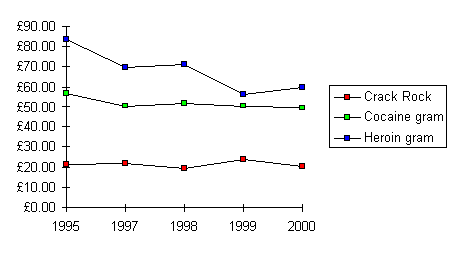
C5 Drug
Ratings
C5.1 Drug
Users were asked to rate each drug (whether or not
they had used it) on a scale of 0-10, with 0 the most
negative and 10 the most positive rating. These figures
give an indication of the popularity and/or social
acceptability of particular drugs within the subculture.
Note this data was only collected from 1994 onwards.
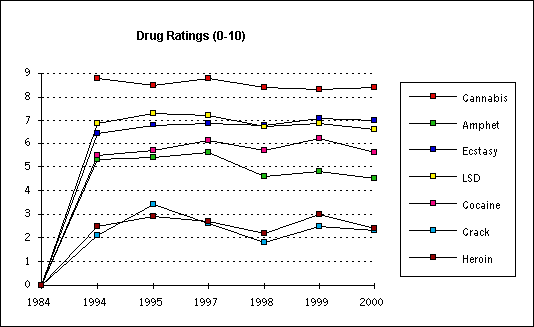
Appendix
D - How can IDMU assist with development of policy
D1 IDMU
can advise Government on much of the baseline data
outlined in Hellawell"s reports, but not available
from "official" sources. We have been conducting
large scale surveys of drug users since 1984, involving
data on frequency of use, consumption levels, demographic
data, indicators (arrest/treatment episodes) and market
data, including attitudes towards and prices of drugs
at street and wholesale levels. Although some of the
data is published, the vast majority remains unpublished
but available for appropriate analyses.
D2 Our
research and experience can assist the Government
on the following aspects of policy:
Drug
Prices & Market Economics
Appropriate
levels of excise duty
Appropriate
limits for personal possession (i.e. limits
below which no action would be taken, or below
which no charges for "intent" would
be brought)
Appropriate
limits for personal cultivation (e.g. maximum
size of flowering area or wattage of lighting)
Legal
distribution systems (e.g. licensed clubs,
cannabis cafes)
Individual
licensing (e.g. for medical users or for small
scale grower/suppliers)
Criteria
for decisions whether or not to prosecute
medicinal cannabis users
Drug
Driving Policy
Research
and Information (questions in future surveys
or data from previous surveys)
|
All contents of this web
site & any links to other sites etc, is for educational
& research purposes. IDMU at no time seeks to encourage
illegal activities. All sections of this site and its contents
are protected under copyright laws. © IDMU
Ltd 1994 - 2008
|
|
|
|